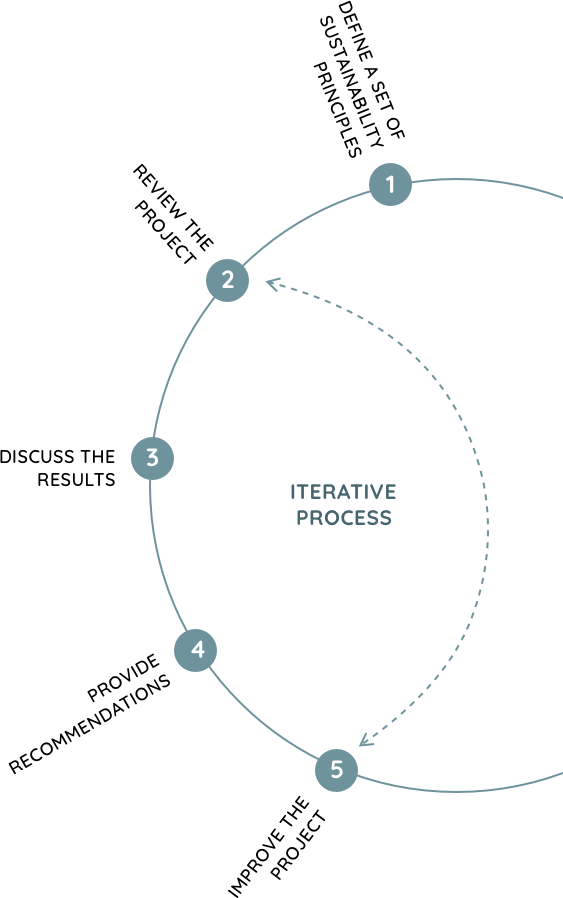THE SDG PROJECT ASSESSMENT TOOL IS AN OFFLINE, DIGITAL AND USER-FRIENDLY INSTRUMENT THAT GUIDES CITY AUTHORITIES TO DEVELOP MORE INCLUSIVE, SUSTAINABLE AND EFFECTIVE URBAN PROJECTS.
The SDG Project Assessment Tool (referred to as SDG Tool) is developed by UN-Habitat as an offline, digital and user-friendly instrument to guide City Authorities and Delivery Partners in the development of more inclusive, sustainable and effective urban projects. The main purpose of the SDG Tool is to increase the alignment of selected urban projects to the SDG's and their city's contexts.
The objective of the SDG Tool is to:
1. Improve the quality of urban projects in the planning, development and design phase to enhance sustainability and inclusiveness;
2. Promote an enabling environment that ensures the implementability and viability of the projects in the medium and long term;
3. Steer a participatory process between City Authorities and Delivery Partners to develop strategies to optimize the project's alignment to the SDGs and the Programme objectives.
The SDG Tool has been developed specifically for the cities and urban projects in the field of urban planning, mobility, resilience and data systems within the Global Future Cities Programme, providing a framework based on existing publications, policy papers and normative principles.
SDG Project Assessment Tool
Testimonials

TPr. Chew Lee Ting

Yeap Kok Peng

Ir Ts Mohammad Afif bin Kasno

YBhg. Datuk Wira Dr. Abu Bakar bin Mohamad Diah

Datuk Zaidi Johari

Breno Alencar

Seda Özdemir (PhD)

Mohd Hafizam Bin Mustaffa

Sertaç Erten
PROCESS
The SDG Tool will be applied periodically throughout the different phases of project implementation as an iterative assessment, triggering discussion among key stakeholders to further improve the projects. It is not is not an instrument for final evaluation.
Application of the SDG Tool will generate recommendations that aim to identify both weaknesses that could be improved on in projects and strengths that could contribute to sharing best practices among cities in the Programme. Instead of creating competition between cities, or city rankings, the SDG Tool will identify common issues and enhance learnings and the exchange of knowledge between the cities.

DEFINE A SET OF SUSTAINABILITY PRINCIPLES
The parties involved will identify a set of Sustainability Principles (approximately 20) relevant for each urban project. The Sustainability Principles (refer to glossary for definition) will be derived from the General Framework and collated into a tailormade worksheet per project. The aim of this step is to ensure the consistency and the relevance of the SDG Tool for the specific project context.

REVIEW THE PROJECT
The parties involved will apply the SDG Project Assessment Tool using the tailor-made worksheet to undertake an assessment of the Milestone Deliverable against the selected Sustainability Principles and the related Performance Criteria. The aim of this review is to identify strengths and weaknesses of the projects implementation.

DISCUSS THE RESULTS
Based on a presentation of the Milestone Deliverable by the Delivery Partner, all parties will engage in a joint discussion on the progress of the project. The discussion will be guided by the preliminary results of the SDG Tool application (Step 2) and will lead to an agreed assessment of the project.

PROVIDE RECOMMENDATIONS
UN-Habitat will compile an SDG Recommendations Report, which will provide recommendations to the Delivery Partner and the Cities Authorities to improve the quality of the project and ensure its sustainability beyond the Programme's timeframe.

IMPROVE THE PROJECT
Both the Delivery Partners and the City Authority will to take into consideration the recommendations of the SDG Recommendation Report to improve the quality of the project implementation and ensure its sustainability beyond the Programme's timeframe.
